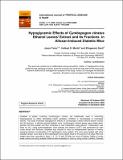| dc.description.abstract | Varieties of plants, including Cymbopogon citratus, are traditionally used in controlling hyperglycemia by either stimulating insulin secretion, inhibition α- Glucosidase or α-amylase activity. This study evaluated hypoglycemic effects of Cymbopogon citratus ethanol leaves' extract and its fractions in alloxan-induced diabetic mice. Cymbopogon citratus leaves were shade dried, grinded into fine powder and then extracted by cold maceration using ethanol. Fractionation was done by VLC using dichloromethane, ethyl acetate and ethanol. OGTT was performed for both crude extract and fractions. Diabetes was induced in mice by intraperitoneal injection of freshly prepared alloxan monohydrate (170 mg/kilogram body weight). The mice were treated with ethyl acetate fraction once daily at 400 mg/kilogram body weight dose for the period of 20 days.FBG and weight were then recorded in days 1, 5, 10, 15 and 20 after six hours of fasting. Safety of crude water extract and ethyl acetate fractions were evaluated in mice by using Lorke’s method, followed by 5 days observation for their mortality and behavioral changes. Comparisons of results among groups were analyzed using One-way ANOVA. The difference between the means of the two population groups (each against negative control) was considered significant at p< 0.05. Results were expressed as mean ± SD. Both crude and ethyl acetate fractions from C. citratus showed significant hypoglycemic activity. Moreover, higher hypoglycemic activity was shown by ethyl acetate fraction (p = 0.004). No mortality was observed at 5000 mg/kilogram body weight dose but sleeping and tremor were observed at a 1000 -5000 mg/kilogram body weight dose. Good hypoglycemic and safety results from ethyl acetate fraction highly suggest that Cymbopogon citratus extracts are effective against insulin-dependent hyperglycemia, which may be contributed by the action of screened alkaloids, saponins, antraquinone, phenol and tannins. Isolation and testing of the active ingredients from the C. citratus extract are thus warranted for use in developing pharmaceutical anti-hyperglycemic drugs from this herbal plant. | en_US |

